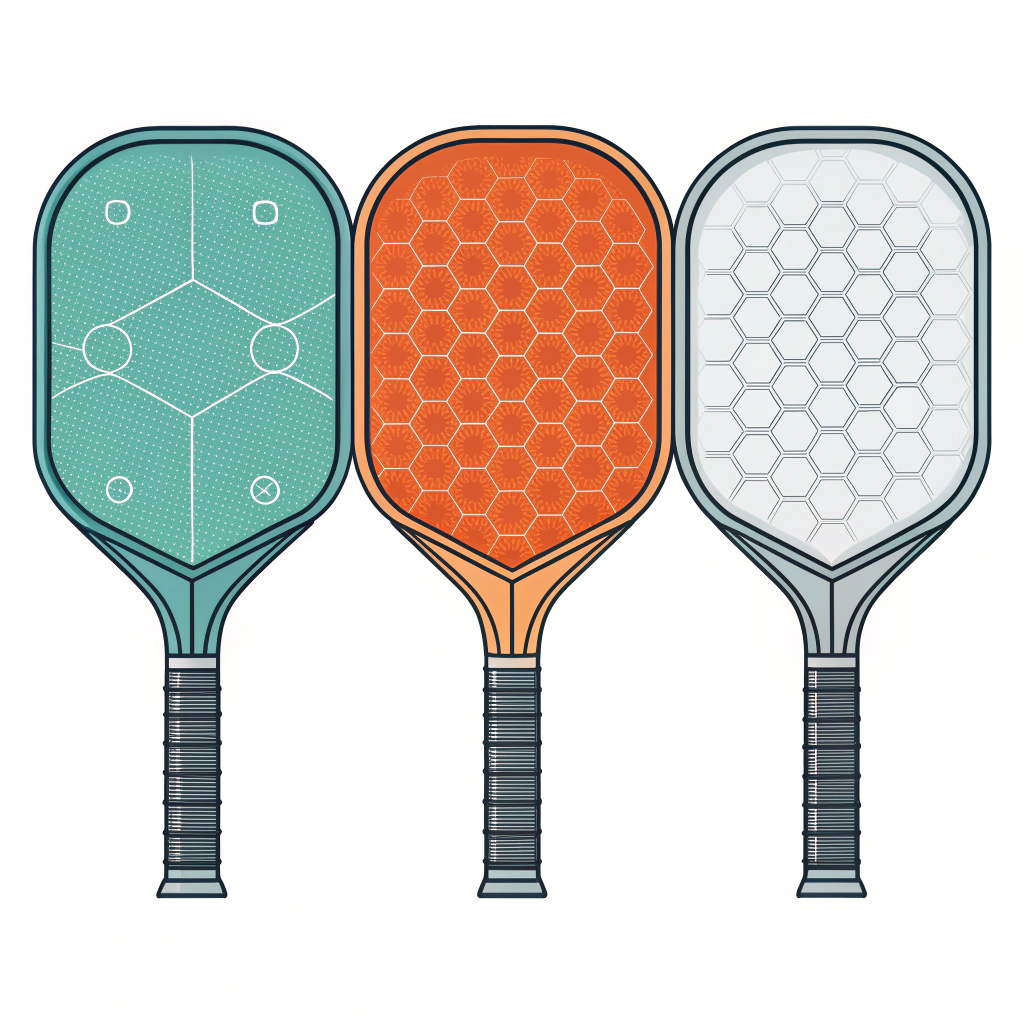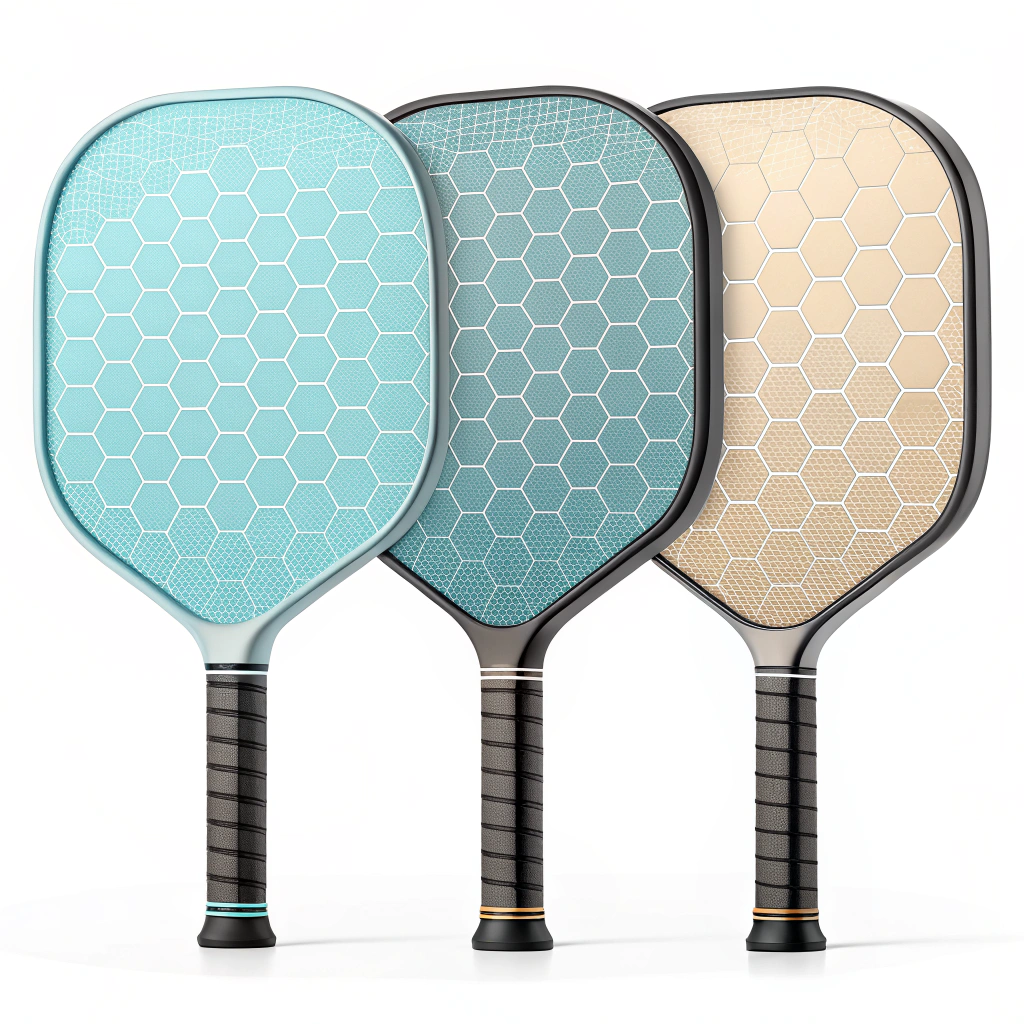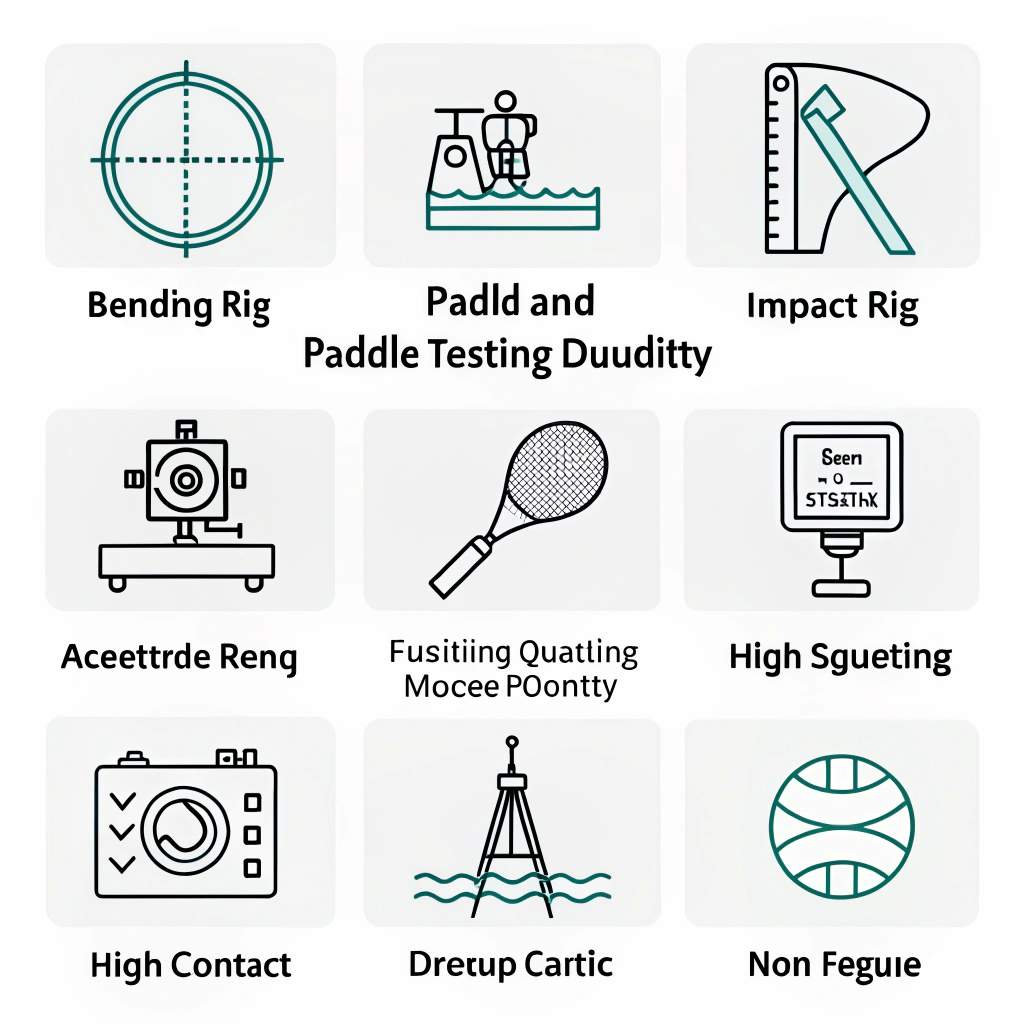Quick answer: There is no single “best” paddle core — choose based on target player and product goals. For a balanced commercial line, polymer honeycomb cores1 deliver the best mix of comfort, consistent dwell time2, and broad market appeal; Nomex honeycomb3 is best when durability and a stiff, powerful feel are the priority; aluminum honeycomb suits designs that target firm response and specific weight/balance goals but increases cost and manufacturing complexity.
Why this decision matters
A paddle’s core controls the paddle’s stiffness, energy return, vibration damping, and long‑term durability. For product managers and OEM buyers, the core choice maps directly to player satisfaction, return rates, price point, and manufacturing constraints. Below we compare the three most relevant cores, explain how core thickness and manufacturing methods influence play, and give concrete OEM spec templates you can use when ordering a production run.
Core types — material behavior and play outcomes
- Polymer honeycomb core (often high‑density polymer): softest in the set. Offers higher elasticity, better shock absorption, and a longer dwell time (ball stays on the face slightly longer). Result: excellent control, comfort, and reduced vibration — preferred by beginners and recreational players, and increasingly by mid‑to‑high level players seeking comfort.
- Nomex honeycomb core (aramid‑based, rigid honeycomb): very stiff and hard. Produces high rebound (power) and quick ball release. Result: greater “pop” and power for aggressive play, but less dwell and more vibration. Very durable under impact — common in performance and tournament paddles.
- Aluminum honeycomb core (lightweight metal honeycomb): a stiff core with a distinct feel — firm with good power and a unique feedback profile. Can be heavier than polymer at the same thickness and requires careful edge sealing and bonding to prevent corrosion/creep issues.
Key material traits and how they translate to play:
- Stiffness → power and quick ball release
- Elasticity/damping → control, feel, less arm vibration
- Fatigue resistance → long‑term durability under repeated impact
- Density/weight → achievable overall paddle weight and balance point
Core comparison table (quick reference)
| Property / Outcome | Polymer Honeycomb | Nomex Honeycomb | Aluminum Honeycomb |
|---|---|---|---|
| Typical feel | Softer, more dwell | Very firm, quick release | Firm, metallic response |
| Power (pop) | Moderate | High | High |
| Control / touch | High | Moderate | Moderate |
| Vibration transmitted | Low | High | Medium-High |
| Durability (impact/fatigue) | Good (depends on density) | Excellent | Good to excellent (depends on bonding) |
| Typical thickness range | 12–16 mm | 12–16+ mm | 12–16 mm |
| Manufacturing ease | Easy to bond, forgiving | Requires heat/pressure control | Requires precise sealing & bonding |
| Typical cost | Low–mid | Mid–high | Mid–high |
How core thickness changes performance
- Thinner cores (12–14 mm): slimmer profile, faster flex, and generally more “pop” — favored by players who want quick power and maneuverability.
- Standard 16 mm cores: provide more stability and control. A thicker core usually reduces raw power and increases stability for blocks, resets, and drop shots.
-
16 mm: less common, used to emphasize control/damping; increases paddle depth and may shift balance toward the head.
Design note: core thickness interacts with face material and paddle geometry. For example, a 14 mm polymer core with a stiff carbon face can produce similar power to a 16 mm polymer core with fiberglass faces but will differ in dwell and vibration.
Manufacturing implications — choosing a core for the factory line
Manufacturing method choices affect yield, cycle time, tooling cost, and final play characteristics. NEX Pickleball supports hot pressing, cold pressing, and thermoforming; below are implications for core choices.
| Process | Best for cores | Pros | Cons |
|---|---|---|---|
| Hot pressing | Nomex, aluminum, polymer (thermosetting composites) | Fast cycle, consistent consolidation, strong bonds | Can change material properties (heat), expensive equipment |
| Cold pressing | Polymer, Nomex (with appropriate adhesives) | Better control of material properties, improved feel | Slower cycle, higher skill required |
| Thermoforming | Complex shapes, composite layups | Enables precise material distribution and edge shaping | Longer cycles, higher tooling & per-piece cost |
Practical notes:
- Nomex cores often require higher pressure and temperature during consolidation to ensure full bonding with the face and stable cell collapse control; hot pressing is common.
- Polymer cores bond well under cold pressing or lower‑temperature hot presses; their elasticity means they tolerate minor process variation better.
- Aluminum cores demand precision edge sealing and bonding to faces to prevent micro-movement and to avoid corrosion. Thermoforming can help with consistent face contours.
Testing metrics and QC you should require
To specify a core for OEM production, include measurable tests on the spec sheet. Recommended tests and why they matter:
- Flexural stiffness / bending modulus4: correlates to perceived paddle stiffness (NEX can provide lab values). Target ranges differ per segment.
- Impact rebound (energy return): measured with standardized drop/impact rigs to quantify “pop.”
- Vibration amplitude and frequency: accelerometer measurement during a controlled impact. Important for arm comfort and NVH (noise/vibration/harshness).
- Dwell time proxy: measured by high‑speed camera for ball contact duration under controlled speed/angle.
- Fatigue / cycle test: repeated impacts to a set energy level until degradation. Provides expected life and failure modes.
- Adhesion and bond strength: peel tests for core-to-face bonds and edge seals.
- Dimensional tolerances: thickness, face flatness, balance point.
Suggested test thresholds (example starting points)
- Recreational: flex modulus lower band; rebound moderate; vibration < threshold X; fatigue cycles >10k
- Club: mid flex modulus; rebound higher; vibration controlled; fatigue cycles >20k
- Pro: higher flex modulus (Nomex or stiff carbon face); rebound high; fatigue cycles >30k
OEM specification templates (copy‑paste ready)
-
Recreational model
- Core: polymer honeycomb core, 14 mm ±0.5 mm
- Face: fiberglass or composite, 3K fiberglass
- Target weight: 7.6–8.2 oz (215–233 g)
- Balance: slightly handle-heavy to neutral
- Process: cold pressing for consistent feel
- QC: flex test, rebound test, adhesion peel >X N
- MOQ: 1k units
-
Club / intermediate model
- Core: polymer honeycomb core (higher density), 15–16 mm ±0.5 mm
- Face: Carbon-fiberglass composite (balanced response)
- Target weight: 7.8–8.4 oz (221–238 g)
- Balance: neutral
- Process: cold press or low-temp hot press
- QC: full test suite (flex, rebound, vibration), labeling for warranty
- MOQ: 500–1k units
-
Competitive / pro model
- Core: Nomex honeycomb core or high‑grade T300 carbon face with 13–14 mm core
- Face: 12K carbon fiber or T300
- Target weight: 7.4–7.9 oz (210–224 g)
- Balance: slightly head-light to neutral
- Process: hot pressing or thermoforming for high consolidation
- QC: extended fatigue (>30k cycles), instrumented vibration testing, certification batch report
- MOQ: 300–1k units
Cost versus performance: procurement angles
- Material cost: Nomex typically more expensive than polymer resins; aluminum cores raise material plus sealing costs.
- Processing cost: hot pressing and thermoforming increase per‑piece cost but deliver better consolidation and repeatability for high‑end lines.
- Yield and scrap: tighter tolerances with Nomex and aluminum mean potentially higher scrap without precise process control.
- Branding and customization: on‑demand print increases SKU complexity but NEX Pickleball supports custom printing and small batch labeling. Consider starting with a core family and varying face layup and thickness to create distinct SKUs with controlled cost.
Decision flow for a product manager
- Define player target and price point. If your range spans from recreational to pro, standardize on a polymer core for mid and entry SKUs and reserve Nomex for premium SKUs.
- Select thickness to modulate control vs power (12–14 mm for power/agility, 16 mm for control/stability).
- Specify manufacturing process matching your desired feel and volume (cold press for feel at mid volumes; hot press for high-performance paddles and high volumes).
- Require measurable testing and a batch QC report with every shipment.
- Plan MOQ and color/print options early to optimize tooling and lead time.
Why work with NEX Pickleball
NEX Pickleball offers hot pressing, cold pressing, and thermoforming under one roof and experience in producing paddles for major brands. We can:
- Validate core + face combinations with pilot runs and lab testing.
- Provide ON‑DEMAND print services for custom branding and low MOQ launches.
- Deliver batch QC reports including flex, rebound, and vibration metrics.
If you want a ready spec sheet or a sample development plan for your SKU, we can translate these recommendations into a production timeline and a cost model.
Summary and next step
Choose the core that fits the player and price target: polymer for comfort and mass market, Nomex for high power and durability, aluminum for specific response and balance goals. Always tie core choice to thickness, face layup, and a matched manufacturing process. When preparing an RFQ, include the test list above and explicit dimensional tolerances. Contact NEX Pickleball to convert your chosen specs into pilot samples and measurable QC standards.
People Also Ask
What is the best core for pickleball?
The best core depends on your priorities. For broad market appeal—comfort, low vibration, and consistent control—polymer honeycomb cores1 are the most versatile. If you prioritize maximum power and extreme durability for competitive play, Nomex honeycomb3 is a strong choice. Aluminum honeycomb gives a firm, distinct response but adds sealing and bonding complexity. Match the core to player level, desired feel, and manufacturing capacity.
What is the best core thickness for a pickleball paddle?
There is no single “best” thickness. Common thickness ranges are 12–14 mm (thinner profile, more pop and quicker release) and 16 mm (standard thickness for more stability and control). Thicker cores generally reduce raw power and improve blocking and touch. Choose thickness to balance power, control, and the preferred feel for your target players.
Do thinner pickleball paddles have more power?
Yes—thinner cores (roughly 12–14 mm) typically allow faster flex and quicker energy release, producing noticeably more “pop” or power. However, power also depends on face material, core stiffness, and paddle mass distribution. A thin core with a soft face may not be as powerful as a thin core paired with a very stiff carbon face.
-
polymer honeycomb cores: Read this article to understand polymer core families, density and cell-structure options, bonding and sealing best practices, and cost-performance tradeoffs relevant to mass-market and mid-level SKUs. Return to polymer honeycomb cores. ↩ ↩2
-
dwell time: Read this article to see how dwell time is measured (high-speed imaging), why it matters for control and player perception, and how face material and core stiffness change contact duration. Return to dwell time. ↩
-
Nomex honeycomb: Read this article to learn about aramid (Nomex) processing requirements, collapse control during consolidation, typical durability profiles, and when Nomex is worth the premium for competitive paddles. Return to Nomex honeycomb. ↩ ↩2
-
flexural stiffness / bending modulus: Read this article to get test methods, typical target ranges per player segment, sample lab reports, and how bending modulus correlates with perceived stiffness and on-court performance. Return to flexural stiffness / bending modulus. ↩







